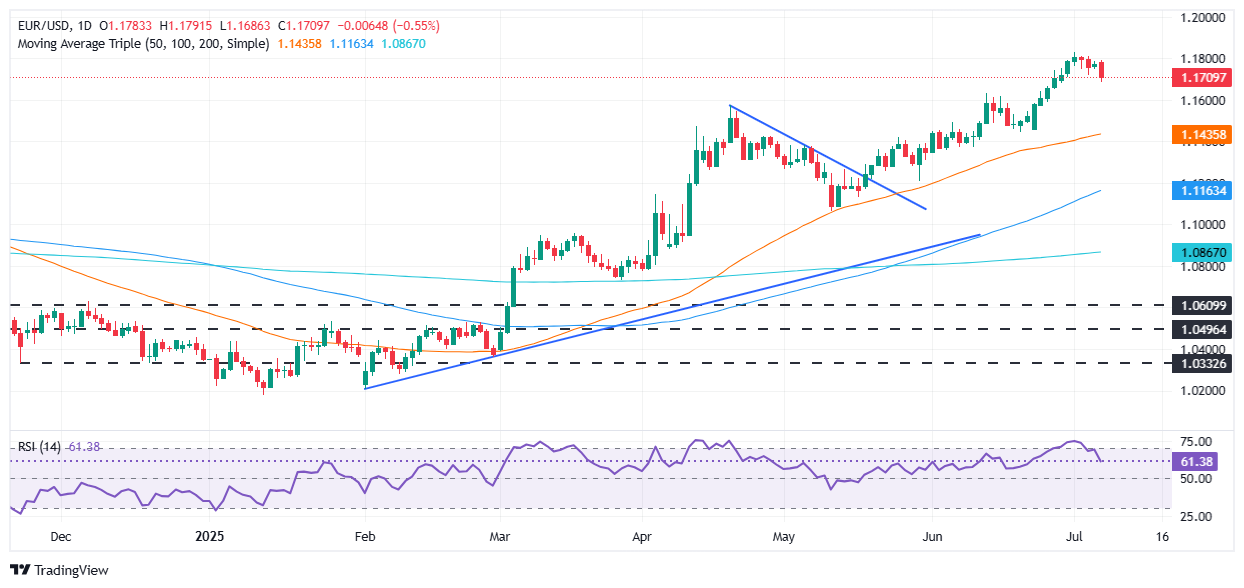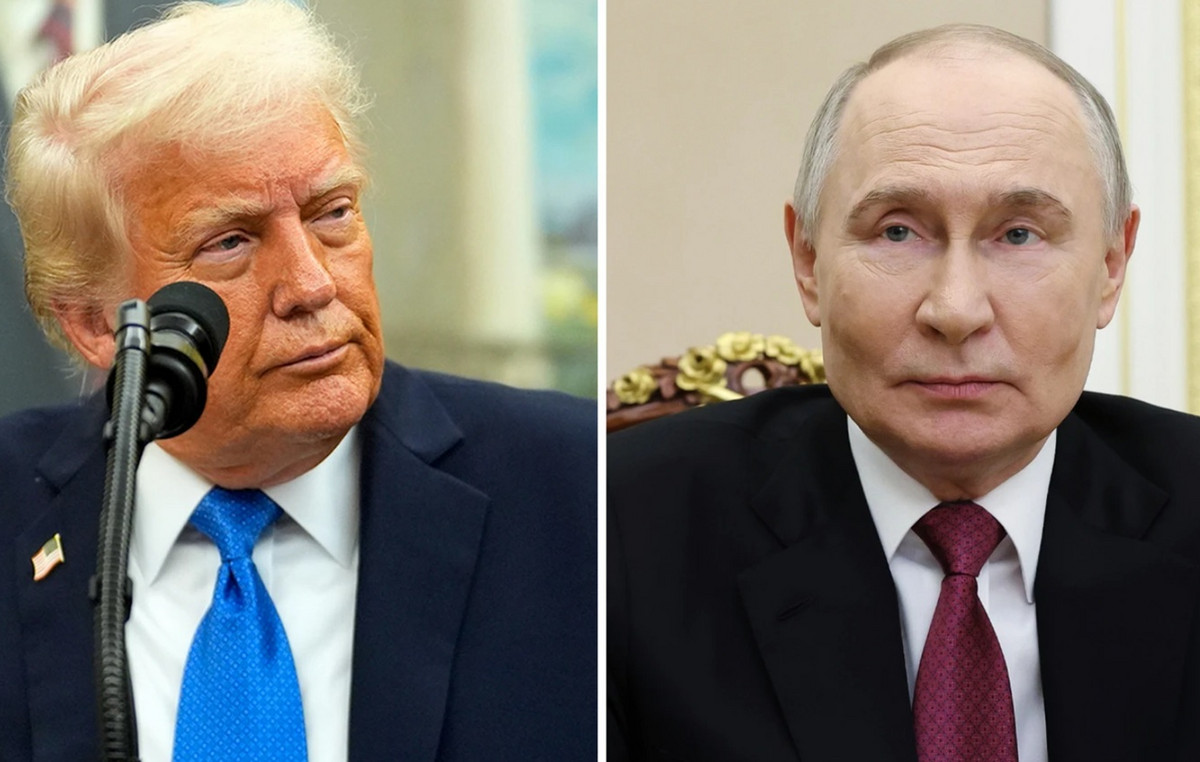- EUR/USD falls 0.44% to 1,1718, reaching a minimum of six days of 1,1686 before a modest rebound.
- Trump imposes tariffs from 25% to 40% to South Korea, Japan, Malaysia and others.
- Reuters: the EU exempt from the last wave of tariffs, helping the recovery of the EUR/USD.
- German industrial production shows a slight improvement in May.
The EUR/USD collapsed on Monday during the North American session in the middle of an impulse of risk aversion, due to an escalation in the commercial war, since the US president, Donald Trump, began sending letters with tariffs imposed to some countries. This promoted the US dollar to the detriment of the shared currency, which lies to 1,1718, with a fall of 0.44%.
Trump announced 25% tariffs to all Korean and Japanese products imported to the US. In addition, he applied rights to Malaysia, Kazakhstan, Burma, Laos and South Africa in a range of 25% to 40%. Once the headlines met, the EUR/USD fell to its lowest level in six days in 1,1686.
However, Reuters revealed that the European Union (EU) would not receive a letter that established higher tariffs by the US, which promoted the EUR/USD again above 1,1700 until its current exchange rate.
Meanwhile, the US economic agenda remains absent on Monday and Tuesday. The operators are attentive to the publication of the minutes of the Federal Open Market Committee (FOMC) of June. In the EU, German industrial production figures for May showed a slight improvement, according to the Federal Statistics Office of Germany.
Euro price today
The lower table shows the percentage of euro change (EUR) compared to the main currencies today. Euro was the strongest currency against the Australian dollar.
| USD | EUR | GBP | JPY | CAD | Aud | NZD | CHF | |
|---|---|---|---|---|---|---|---|---|
| USD | 0.63% | 0.40% | 1.34% | 0.58% | 1.07% | 1.12% | 0.63% | |
| EUR | -0.63% | -0.21% | 0.46% | -0.07% | 0.50% | 0.49% | -0.00% | |
| GBP | -0.40% | 0.21% | 0.66% | 0.16% | 0.73% | 0.71% | 0.09% | |
| JPY | -1.34% | -0.46% | -0.66% | -0.52% | -0.06% | 0.01% | -0.64% | |
| CAD | -0.58% | 0.07% | -0.16% | 0.52% | 0.50% | 0.54% | -0.08% | |
| Aud | -1.07% | -0.50% | -0.73% | 0.06% | -0.50% | 0.09% | -0.62% | |
| NZD | -1.12% | -0.49% | -0.71% | -0.01% | -0.54% | -0.09% | -0.61% | |
| CHF | -0.63% | 0.00% | -0.09% | 0.64% | 0.08% | 0.62% | 0.61% |
The heat map shows the percentage changes of the main currencies. The base currency is selected from the left column, while the contribution currency is selected in the upper row. For example, if you choose the euro of the left column and move along the horizontal line to the US dollar, the percentage change shown in the box will represent the EUR (base)/USD (quotation).
What moves the market today: He Dollar is strengthened in a state of risk aversion; The euro collapses
- The dollar strength presses the EUR/USD. The US dollar index (DXY), which tracks the value of the dollar against a basket of six coins, rises 0.56% to 97.53.
- The White House has sent a total of 7 Letters to the following countries, with their corresponding tariffs: South Korea (25%), Japan (25%), Malaysia (25%), Kazakhstan (25%), Laos (40%), South Africa (30%) and Burma (40%). These levies will be applied on August 1.
- The president of the USA, Donald Trump, declared that the rates did not include “specific tariffs by sector.” Meanwhile, the White House announced that the 90 -day deadline established on the day of April 2 has extended until August 1.
- The EU declared that there have been some advances in a Marco Commercial Agreement with the United States (USA), according to EU spokesman Olof Gill. He indicated that Ursula von der Leyen had a call with Trump on Sunday, saying that “they had a good exchange.”
- German industrial production in May increased more than expected, increasing 1.2% monthly, exceeding 0% forecasts. In annual terms, it improved from the fall of 1.6% in April to an expansion of 1%. Franziskka Palmas, a senior economist from Europe in Capital Economics, said: “German industrial production figures better than expected for May are partly due to the continuous anticipation of tariffs in the pharmaceutical sector.”
EURO TECHNICAL PERSPECTIVE: EUR/USD falls, bears point to 1,1700
The EUR/USD slides downward in the daily chart, threatening to print a new minimum of seven days below the minimum of the June 27, 1,1680 cycle, which could clear the way to challenge 1,1650 and the simple mobile average (SMA) of 20 days in 1,1622. A greater decrease in 1,1600 is expected.
The relative force index (RSI) suggests that buyers are losing impulse as the RSI falls abruptly towards its neutral level.
On the contrary, if the EUR/USD remains above 1,1700, the following key resistance would be 1,1750, the level of 1,1800 and the maximum of the year to date (YTD) of 1,1829.

EURO – FREQUENT QUESTIONS
The euro is the currency of the 19 countries of the European Union that belong to the Eurozone. It is the second most negotiated currency in the world, behind the US dollar. In 2022, it represented 31 % of all foreign exchange transactions, with an average daily business volume of more than 2.2 billion dollars a day. The EUR/USD is the most negotiated currency pair in the world, with an estimate of 30 %of all transactions, followed by the EUR/JPY (4 %), the EUR/GBP (3 %) and the EUR/AU (2 %).
The European Central Bank (ECB), based in Frankfurt (Germany), is the Eurozone reserve bank. The ECB establishes interest rates and manages monetary policy. The main mandate of the ECB is to maintain price stability, which means controlling inflation or stimulating growth. Its main tool is the rise or decrease in interest rates. Relatively high interest rates (or the expectation of higher types) usually benefit the euro and vice versa. The GOVERNMENT BOOK of the ECB makes decisions about monetary policy in meetings that are held eight times a year. The decisions are made by the directors of the National Banks of the Eurozone and six permanent members, including the president of the ECB, Christine Lagarde.
Eurozone inflation data, measured by the harmonized consumer prices index (IPCA), are an important economic indicator for the euro. If inflation increases more than expected, especially if it exceeds 2% of the ECB, it forces the ECB to rise interest rates to control it again. Relatively high interest rates compared to their counterparts usually benefit the euro, since they make the region more attractive as a place for global investors to deposit their money.
Published data measure the health of the economy and can have an impact on the euro. Indicators such as GDP, manufacturing and services PMIs, employment and consumer trust surveys can influence the direction of the single currency. A strong economy is good for the euro. Not only attracts more foreign investment, but it can encourage the ECB to raise interest rates, which will directly strengthen the euro. Otherwise, if economic data is weak, the euro is likely to fall. The economic data of the four largest economies in the euro zone (Germany, France, Italy and Spain) are especially significant, since they represent 75% of the economy of the euro area.
Another important fact that is published on the euro is the commercial balance. This indicator measures the difference between what a country earns with its exports and what you spend on imports during a given period. If a country produces highly demanded export products, its currency will gain value simply by the additional demand created by foreign buyers seeking to buy those goods. Therefore, a positive net trade balance strengthens a currency and vice versa in the case of a negative balance
Source: Fx Street
I am Joshua Winder, a senior-level journalist and editor at World Stock Market. I specialize in covering news related to the stock market and economic trends. With more than 8 years of experience in this field, I have become an expert in financial reporting.







